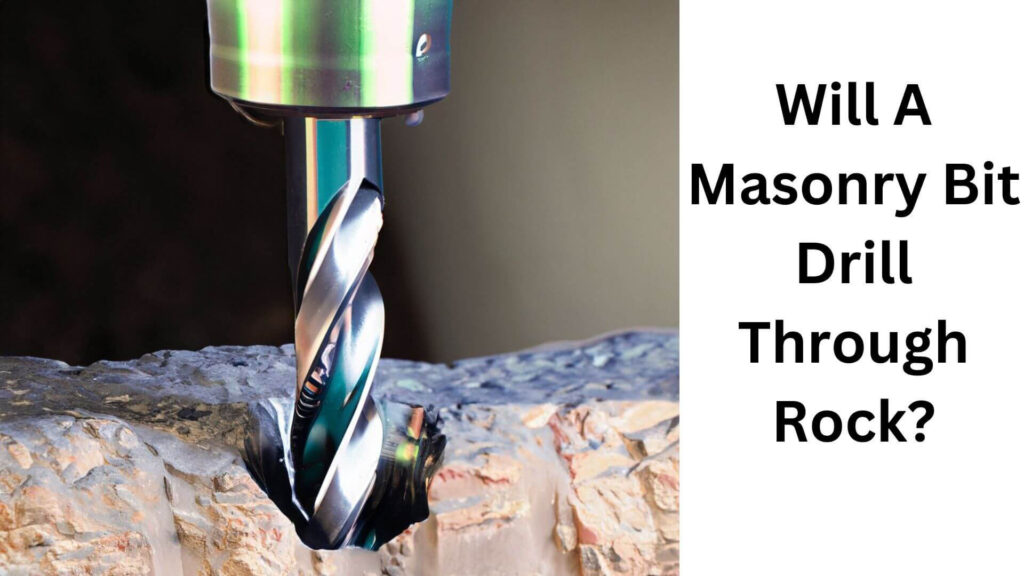Are you planning to drill through rock and wondering if a masonry bit can do the job? You’re not alone. Many DIY enthusiasts and professionals alike often ask this question.
The short answer is yes, a masonry bit can drill through rock. Masonry bits have a carbide tip that is strong enough to penetrate through solid surfaces like concrete, brick, and even natural stone. but it depends on the rock type and the material’s hardness.
So, before you begin your drilling project, you must clearly understand the material you’ll be drilling through. In this article, I’ll explore the factors determining whether a masonry bit can drill through rock and provide tips on getting the job done right. So, let’s dive in and get drilling!
Table of Contents
What is Masonry Bits?
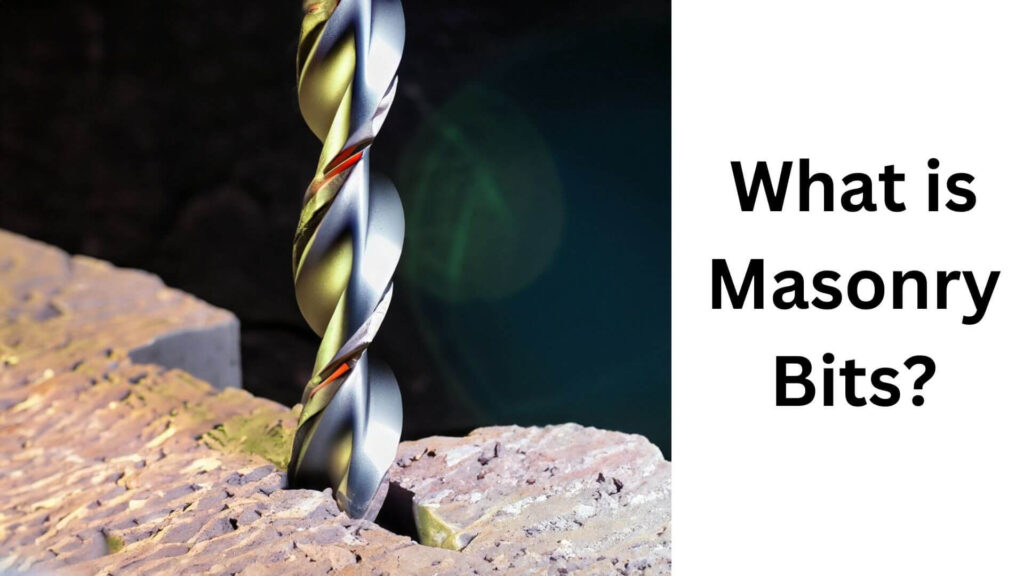
Masonry bits are designed to drill through hard materials such as masonry, brick, stone, concrete, and tiles. These bits come in different sizes and shapes, but they all specialise in creating holes in hard surfaces.
They are commonly used in construction and DIY projects, as well as in mining and quarrying.
Different Types Of Masonry Bits Available In The Market

There are various types of masonry bits available in the market. Each type is designed for a specific drilling job, and understanding the different types will help you find the suitable one for your task.
- Straight shank masonry bit: this type of bit has a straight shank and is suitable for use with a standard drill chuck.
- Sds masonry bit: this bit is designed for use with a hammer drill and has an Sds shank that helps to reduce slippage.
- Carbide-tipped masonry bit: this bit has tungsten carbide tips that help it to drill through hard surfaces.
- Diamond-tipped masonry bit: this bit has a diamond-coated tip that makes it suitable for drilling through rigid materials such as granite and porcelain.
Check Also: Some Powerfull Drill Bits for Rock.
How To Choose A Suitable Masonry Bit For Your Drilling Job
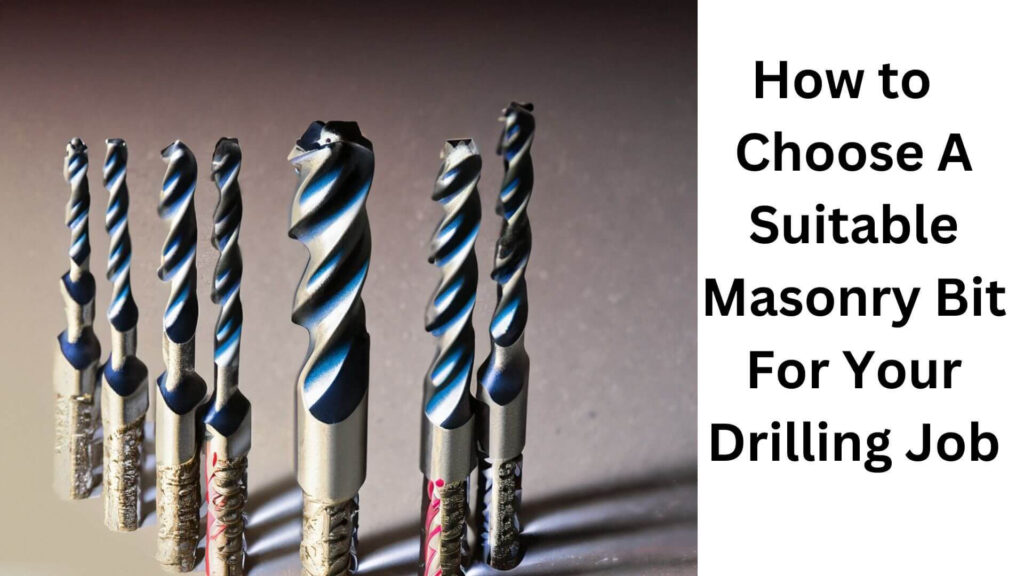
Choosing the right masonry bit is crucial for successful drilling.
- Material: choose a bit designed for the material you are drilling. For example, use a diamond-tipped bit for drilling through granite and a carbide-tipped bit for drilling through concrete.
- Bit size: ensure that the bit size is the right size for your holes.
- Shank type: choose a bit with a shank compatible with your drill.
- Quality: invest in a good quality bit that will last longer and provide better results.
Masonry bits can drill through rock and other hard materials, but choosing the correct bit type is essential.
Understanding the different types of masonry bits and their usefulness can help you decide when to select the right bit for your drilling job.
Factors That Determine The Drill Bit’S Ability To Penetrate Rock
1. Working Mechanism Of The Masonry Bit
Masonry bits are primarily used for drilling through soft to medium-hard concrete, brick, or stone. However, their ability to penetrate solid rock will depend on various factors. Understanding how the masonry bit works will help determine its ability to drill through rocks.
A masonry bit usually has a tungsten carbide tip, which is extremely hard and designed to grind or cut through hard materials.
The bit’s tip is wider than the shaft and has a spiral groove or flute, allowing debris to escape during drilling. As the bit rotates, the tip grinds through the rock, and the debris is removed from the hole.
2. Material Composition Of Rock And Its Density
The rock’s composition and density will significantly impact the drill bit’s ability to penetrate it.
Soft to medium-hard rocks such as limestone, sandstone, and shale are easy for masonry bits to penetrate. In contrast, hard rocks like granite or basalt are significantly more challenging to penetrate.
The density of the rock also plays a crucial role. The denser the rock, the more resistance the bit will encounter, affecting the drilling process.
3. Weight And Power Of The Drilling Machine
The weight and power of the drilling machine will also determine the bit’s ability to penetrate the rock. A heavier drilling machine applies more pressure to the bit, increasing its ability to penetrate the rock.
A powerful drilling machine provides high torque, which allows the bit to cut into more solid materials.
4. Lubrication And Cooling Fluids Used In The Drilling Process
The drilling process generates heat, damaging the bit and the rock. Lubrication and cooling fluids aid in improving the drilling process and protecting the bit.
Using water or any cooling fluid reduces the heat generated during the drilling process, keeping the bit cool and preventing it from getting damaged. Lubrication fluids protect the bit’s wear and tear during the drilling process.
Masonry bits can drill through rock, but their ability to penetrate depends on the abovementioned factors. Understanding the factors can help you choose the right bit and machine for your drilling needs.
Will A Masonry Bit Preparing To Drill Through Rock?
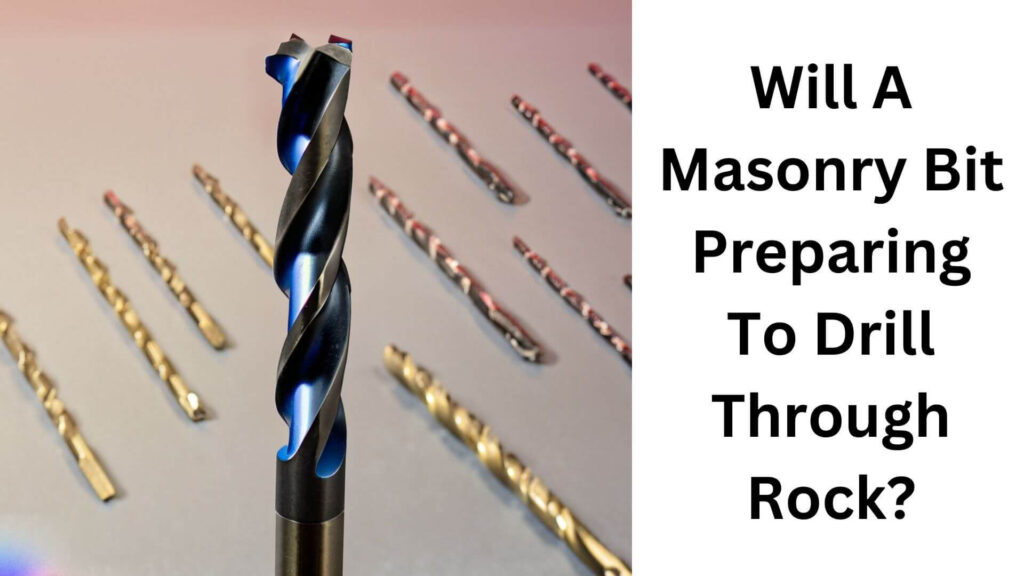
Drilling through rock may seem daunting, but it is possible to achieve with the right tools and preparation. A masonry bit, designed to drill through hard materials such as concrete and brick, can effectively drill through rock.
1. Safety Precautions When Drilling Through Rock
When drilling through rock, safety should always be your top priority.
- Wear protective gear such as safety glasses, gloves, and earplugs to protect your eyes, hands, and ears.
- Keep your workplace clean and dry to avoid slips and trips.
- Use a sturdy drill and ensure it is connected to a power source with ground fault circuit interrupter (GFI) protection.
- Ensure the drill bit is securely fastened to the drill and working correctly.
- Use a steady hand and apply moderate pressure to prevent the drill slipping.
2. Preparing The Surface Area For Drilling
Before drilling through rock, it is essential to prepare the surface area accurately.
- Clean the surface area of any debris or dirt. If possible, use a brush to remove any loose stones or dust.
- Mark the drilling spot with a pencil or marker where you want to drill the hole.
- Create a small dimple with a hammer and a nail to prevent the drill bit from slipping.
3. Choosing The Right Drilling Location And Orientation
Choosing the correct drilling location and orientation is critical when drilling through rock.
- Check the rock’s surface texture to ensure it is solid and capable of drilling.
- Choose a level and stable surface area for drilling.
- Hold the drill perpendicular to the rock surface to prevent the bit from breaking.
- Drill with a moderate speed and apply firm but not excessive pressure to prevent the bit from breaking.
Drilling through rock is achievable with proper preparation, tools, and safety precautions.
Following the steps outlined in this post, you can drill your hole accurately without causing injury or damaging your equipment.
Always prioritize safety, prepare the surface area, and choose the right drilling location and orientation for success.
Step-By-Step Guide On How To Drill Through Rock
Here’s a step-by-step guide to help you drill through rock with a masonry bit:
Step 1: Choose the right masonry bit
You should choose a masonry bit specifically designed for drilling through rock. You can search for these bits at most hardware stores.
Step 2: Prepare the work area
Remove any debris from the work area, and make sure the surface is clean and level.
Step 3: Mark the hole
Use a marker to mark where you want to drill the hole.
Step 4: Start slowly
When drilling, use a slow speed and light pressure. This will help the bit to grip the rock and prevent it from slipping or bouncing.
Step 5: Use water as a coolant
Keep a spray bottle handy, and spray some water onto the drill bit and rock as you drill. This will help to cool the bit and prevent it from overheating.
Step 7: Increase speed and pressure
As you drill deeper into the rock, you can increase the speed of the drill and apply more pressure. Be careful not to apply too much pressure, which can damage the bit.
Step 8: Withdraw the bit regularly
Withdraw the bit from the hole regularly to remove any debris and dust.
Keep the bit lubricated: add lubrication such as oil or grease to the bit regularly to keep it lubricated and prevent it from overheating.
Read More: Can A Sds Bit Be Used To Drill Rock?
How To Maintain And Sharpen The Masonry Bit
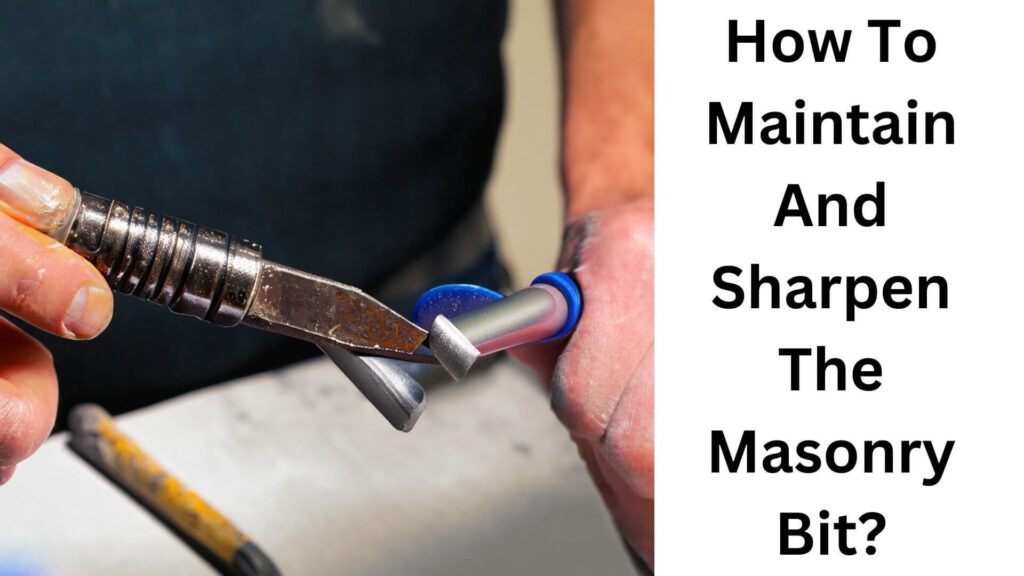
If you use them frequently, masonry bits can get dull over time.
- Clean the bit: remove any debris or dust after use. You can use a wire brush or compressed air to do this.
- Sharpen the bit: if the bit becomes dull, you can use a sharpening stone to sharpen the cutting edge. Make sure to follow the manufacturer’s instructions for sharpening.
- Store the bit properly: store the bit in a dry, clean place.
By following these simple steps, you can successfully drill through rock with a masonry bit. Always take safety precautions, wear protective gear, and use the right tools. Happy drilling!
Read More: How To Sharpen Rock Drill Bits With Ease?
Alternatives To Drilling Through Rock With A Masonry Bit
Have you ever tried to drill through rock with a masonry bit? It’s a challenging task that requires a lot of time, effort, and patience. Unfortunately, even with all of these, you may still be unable to complete the job.
In such situations, it’s essential to consider alternative drilling approaches to make the work more accessible and efficient.
When Drilling Through Rock With A Masonry Bit May Not Be Feasible
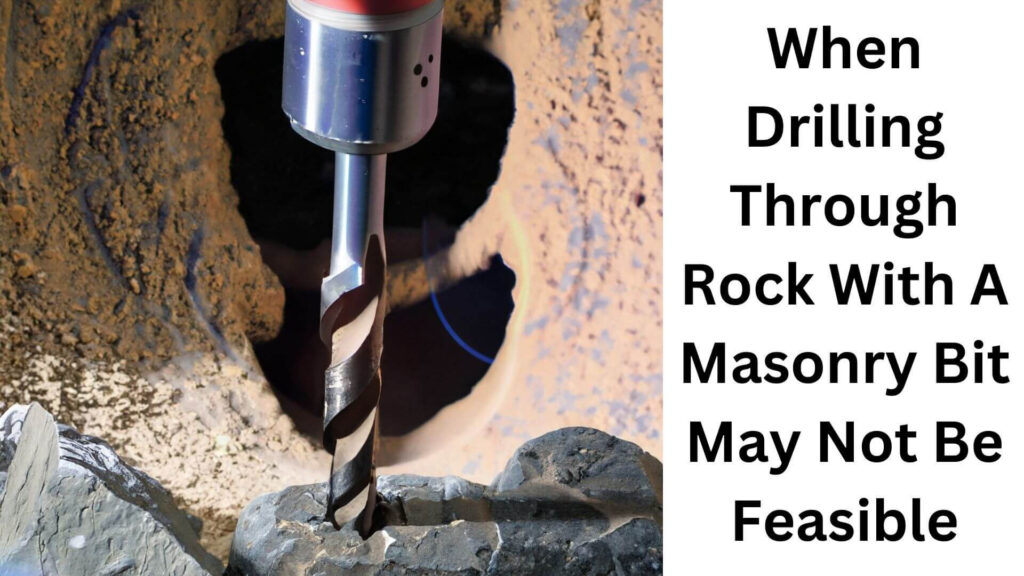
Drilling through rock with a masonry bit can be frustrating, especially when the rock is thick and hard.
- The rock is too hard: if the rock is too hard, applying too much pressure can damage your masonry bit, rendering it ineffective.
- The rock is too thick: if it is too thick, it can take a long time to drill through it with a masonry bit. You should invest in a more effective tool to get the work done.
- The rock is jagged or irregular: when the surface of the rock is irregular, drilling in a straight line is a challenging task. The risk of damaging your bit in this type of situation is high.
Alternative Drilling Approaches
Fortunately, there are other drilling approaches that can be helpful when drilling through rock.
1. Diamond Core Drilling
This is an excellent option when drilling through tough rocks or materials like granite. Diamond core drilling involves using a set of diamond-impregnated bits or wheels to grind the rock away. Since diamond is the hardest mineral known, it can easily cut through rocks.
The technique is efficient, precise, and highly effective compared to using a regular masonry bit.
2. Rotary Drilling
This approach uses a rotary drilling machine fitted with a tritone or tungsten carbide drill bit. The drill bit rotates and grinds the rock away while at the same time removing the rock debris from the hole.
Rotary drilling is suitable for digging large diameter holes and works well when drilling through hard rocks.
3. Hydraulic Splitting
Hydraulic splitting is an effective method of splitting large rocks using hydraulic power. This method drills a small hole into the rock, and a hydraulic cylinder is inserted. The cylinder is then powered, creating a split in the rock.
This method is ideal for creating a clean split in large rocks, and though it may take some time, it’s an excellent option to consider.
Drilling through rock with a masonry bit can be difficult, time-consuming, and sometimes impossible. It’s important to understand that drilling through rock with a masonry bit may not be feasible and consider alternative drilling approaches. The above means of drilling through rocks are efficient and effective and can make drilling through rock less hassle.
Frequently Asked Questions On Will A Masonry Bit Drill Through Rock?
What Types Of Rock Can A Masonry Bit Drill Through?
A masonry bit can drill through soft, porous rocks like sandstone and limestone.
Can A Masonry Bit Drill Through Solid Granite?
Yes, a masonry bit can drill through solid granite if it’s a high-grade carbide-tipped bit.
How Long Does It Take To Drill Through Rock Using A Masonry Bit?
The time it takes to drill through rock using a masonry bit depends on the hole’s hardness, depth, and diameter required.
Do I Need Special Equipment For Drilling Through Rock?
To drill through rock, you need a hammer drill, a masonry bit, and some water to cool the bit down.
What Is The Difference Between A Masonry Bit And A Regular Drill Bit?
Masonry bits have a carbide tip and are designed for drilling through hard materials like concrete, brick, and stone in some cases.
Recap Of The Major Points Covered In The Article
Before you dive into our final thoughts on drilling through rock with a masonry bit, let’s quickly review the major points covered in this article:
- Masonry bits can drill through some types of rock, depending on how hard it is and the size of the bit.
- Choosing the right masonry bit is crucial to successfully drilling through rock.
- The drilling process should be slow and steady, using water as a lubricant to prevent overheating.
- Safety measures must be taken when working with power tools, particularly when drilling through rock.
Final Thoughts On Drilling Through Rock With The Masonry Bit
Now that I’ve reviewed the major points covered in this article, let’s discuss my final thoughts on drilling through rock with a masonry bit.
- Firstly, it’s essential to acknowledge that drilling through rock with a masonry bit is only sometimes successful. Some rock types are simply too complex or dense for the bit to penetrate; in these cases, a different tool may be required.
- However, if you’re confident that a masonry bit is the right tool for the job, it’s worth choosing the right bit and following the correct drilling process. This will significantly increase your chances of success.
- Finally, safety should always be your top priority when working with power tools. Be sure to wear appropriate safety gear and take precautions to prevent accidents.
A masonry bit can drill through some rock types, but success depends on various factors. You can increase your chances of successful results by carefully selecting the right bit and following the correct drilling process. Just remember always to prioritize safety when working with power tools.

Hey, I am Shihab Uddin, I’m a huge fan of DIY crafts. My workshop is where I spend most of my spare time, and I’m always working on some project. To that end, I’d like to share some of my knowledge and experience with you in power tools, woodworking, and other specialized materials fabrication.
I will guide you with genuine knowledge that can assist you with deciding whether a drill is appropriate according to your requirements or not. If you want to find the best drill and know which type of drill is most suited for your needs, then I can guide you with my expertise. My passion lies in helping others find the correct products they need at an affordable price.

